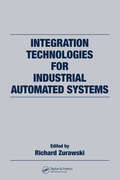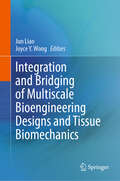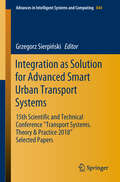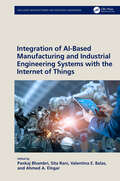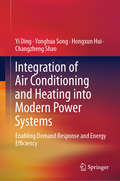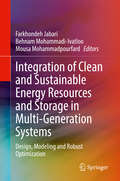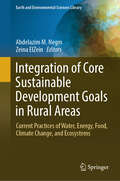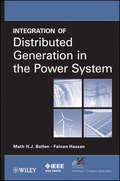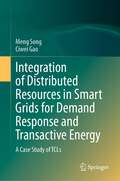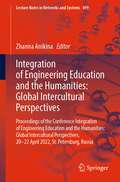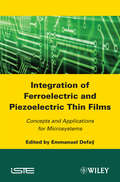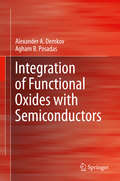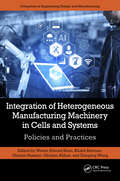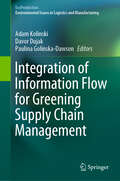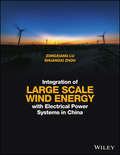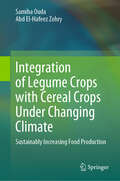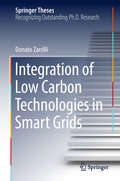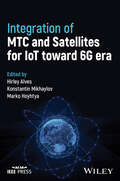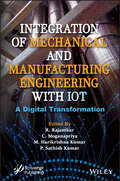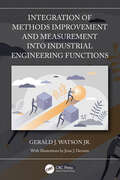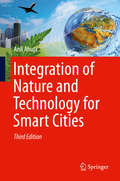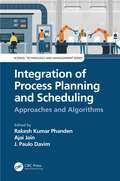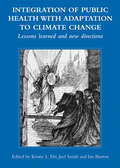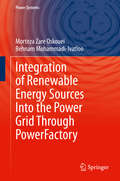- Table View
- List View
Integration Technologies for Industrial Automated Systems (Industrial Information Technology)
by Richard ZurawskiIf there exists a single term that summarizes the key to success in modern industrial automation, the obvious choice would be integration. Integration is critical to aligning all levels of an industrial enterprise and to optimizing each stratum in the hierarchy. While many books focus on the technological components of enterprise information systems, Integration Technologies for Industrial Automated Systems is the first book to present a comprehensive picture of the technologies, methodologies, and knowledge used to integrate seamlessly the various technologies underlying modern industrial automation and information systems.In chapters drawn from two of Zurawski's popular works, The Industrial Communication Technology Handbook and The Industrial Information Technology Handbook, this practical guide offers tutorials, surveys, and technology overviews contributed by experts from leading industrial and research institutions from around the world. The book is organized into sections for cohesive and comprehensive treatment. It examines e-technologies, software and IT technologies, communication network-based technologies, agent-based technologies, and security in detail as well as their role in the integration of industrial automated systems. For each of these areas, the contributors discuss emerging trends, novel solutions, and relevant standards.Charting the course toward more responsive and agile enterprise, Integration Technologies for Industrial Automated Systems gives you the tools to make better decisions and develop more integrated systems.
Integration and Bridging of Multiscale Bioengineering Designs and Tissue Biomechanics
by Jun Liao Joyce Y. WongThis book covers up-to-date knowledge of how designs found in nature use tissue hierarchies to achieve optimal functions, and how these principles are applied in bioengineering. The hierarchy-based multiscale approach has the potential to drive novel biomaterial designs, advance tissue engineering and regeneration, assist in tissue-function integration, improve high-fidelity computational modeling aided by machine learning, and enhance the development of innovative characterization tools and methodologies. This book presents the latest high-impact research achievements in bioengineered and natural hierarchical systems within a clinical context. Our aim is two-fold: (i) to emphasize the importance of integrating and bridging bioengineering designs at various tissue hierarchical levels and (ii) to foster dialogue and collaboration among bioengineers, biomechanists, and clinicians.
Integration as Solution for Advanced Smart Urban Transport Systems: 15th Scientific and Technical Conference “Transport Systems. Theory & Practice 2018”, Selected Papers" (Advances in Intelligent Systems and Computing #844)
by Grzegorz SierpińskiMethods of advanced data collecting and their analysis, models which help with decision problems as well as technical solutions which improve the integrity of contemporary transport systems at urban area are only some of many problems connected with integration in passenger and freight transport which have been discussed in this book. The book expresses case study-based scientific and practical approach to the problems of contemporary transport systems. The proposed methods and models enable a system approach to assess current solutions. In turn, implementation proposals may support the improvement of the integrity of individual elements of transport systems, and thus increase its effectiveness on the global scale.With regard to the research results discussed and the selected solutions applied, the book primarily addresses the needs of three target groups:• Scientists and researchers (ITS field)• Local authorities (responsible for the transport systems at the urban and regional level)• Representatives of business (traffic strategy management) and industry (manufacturers of ITS components).This book gathers selected papers presented at the 15th Scientific and Technical Conference “Transport Systems. Theory and Practice” organised by the Department of Transport Systems and Traffic Engineering at the Faculty of Transport of the Silesian University of Technology. The conference was held in Katowice, Poland on September 17–19, 2018.
Integration of AI-Based Manufacturing and Industrial Engineering Systems with the Internet of Things (Intelligent Manufacturing and Industrial Engineering)
by Valentina E. Balas Ahmed A. Elngar Pankaj Bhambri Sita RaniIntegration of AI-Based Manufacturing and Industrial Engineering Systems with the Internet of Things describes how AI techniques, such as deep learning, cognitive computing, and Machine Learning, can be used to analyze massive volumes of data produced by IoT devices in manufacturing environments. The potential benefits and challenges associated with the integration of AI and IoT in industrial environments are explored throughout the book as the authors delve into various aspects of the integration process. The role of IoT-enabled sensors, actuators, and smart devices in capturing real-time data from manufacturing processes, supply chains, and equipment is discussed along with how data can be processed and analyzed using AI algorithms to derive actionable insights, optimize production, improve quality control, and enhance overall operational efficiency. A valuable resource for researchers, practitioners, and professionals involved in the fields of AI, IoT, manufacturing systems, and industrial engineering, and combines theoretical foundations, practical applications, and case studies.
Integration of Air Conditioning and Heating into Modern Power Systems: Enabling Demand Response and Energy Efficiency
by Yi Ding Yonghua Song Hongxun Hui Changzheng ShaoThis book focuses on the integration of air conditioning and heating as a form of demand response into modern power system operation and planning. It presents an in-depth study on air conditioner aggregation, and examines various models of air conditioner aggregation and corresponding control methods in detail. Moreover, the book offers a comprehensive and systematic treatment of incorporating flexible heating demand into integrated energy systems, making it particularly well suited for readers who are interested in learning about methods and solutions for demand response in smart grids. It offers a valuable resource for researchers, engineers, and graduate students in the fields of electrical and electronic engineering, control engineering, and computer engineering.
Integration of Clean and Sustainable Energy Resources and Storage in Multi-Generation Systems: Design, Modeling and Robust Optimization
by Behnam Mohammadi-Ivatloo Farkhondeh Jabari Mousa MohammadpourfardThis book presents design principles, performance assessment and robust optimization of different poly-generation systems using renewable energy sources and storage technologies. Uncertainties associated with demands or the intermittent nature of renewables are considered in decision making processes. Economic and environmental benefits of these systems in comparison with traditional fossil fuels based ones are also provided. Case studies, numerical results, discussions, and concluding remarks have been presented for each proposed system/strategy. This book is a useful tool for students, researchers, and engineers trying to design and evaluate different zero-energy and zero-emission stand-alone grids.
Integration of Core Sustainable Development Goals in Rural Areas: Current Practices of Water, Energy, Food, Climate Change, and Ecosystems (Earth and Environmental Sciences Library)
by Abdelazim M. Negm Zeina ElZeinThis book addresses the application of the water, energy and food nexus in the MENA Region. It highlights the technologies and solutions to support the sustainable development of rural areas in the region. The first part provides an introduction and an overview of water, energy food, climate change, and ecosystem interactions within the framework of sustainable development goals. The editors present a brief overview and highlights of the book themes and chapters. The second part discusses current State and Security of the WEF Nexus in the MENA Region, addresses the role of water, energy and food nexus in sustainable development through reviewing case studies in the MENA Region that have followed an integrated nexus approach. The third part focuses on the integration within the Nexus for Rural Development, includes three chapters. It discusses analysis and assessment of the nexus through a quantitative index approach to consider the efficiency and security of resources; addresses territorial climate planning in water-scarce areas, focusing on the Souss Massa Region in Morocco; and discusses the Algerian food system and future scenarios through the lens of food and water challenges. The fourth part addresses the WEF Nexus and sustainable development solutions and technologies; exploration of an adaptation model for food security and water resources, water-agricultural management practices; standardized hydraulic incident index to analyze hydraulic incidents and their impact on energy; integrated management of natural resources in Egypt through the WEF nexus approach; and ICT tools as a facilitator for collaborative governance of water resources in Mediterranean agriculture. The fifth chapter focuses on sediment management in the context of climate change for the Fertile Crescent and Southwest Asia, and the Nile River. It also addresses haloculture as a climate change adaptation and mitigation solution, that supports food security. Finally, the book presents key updates, conclusions and recommendations from the book chapters. The book is useful to researchers, professionals, practitioners, post-graduates and undergraduates who are interested in the field of sustainable development and water, energy and food interaction.
Integration of Distributed Generation in the Power System
by Math H. Bollen Fainan HassanThe integration of new sources of energy like wind power, solar-power, small-scale generation, or combined heat and power in the power grid is something that impacts a lot of stakeholders: network companies (both distribution and transmission), the owners and operators of the DG units, other end-users of the power grid (including normal consumers like you and me) and not in the least policy makers and regulators.There is a lot of misunderstanding about the impact of DG on the power grid, with one side (including mainly some but certainly not all, network companies) claiming that the lights will go out soon, whereas the other side (including some DG operators and large parks of the general public) claiming that there is nothing to worry about and that it's all a conspiracy of the large production companies that want to protect their own interests and keep the electricity price high.The authors are of the strong opinion that this is NOT the way one should approach such an important subject as the integration of new, more environmentally friendly, sources of energy in the power grid. With this book the authors aim to bring some clarity to the debate allowing all stakeholders together to move to a solution. This book will introduce systematic and transparent methods for quantifying the impact of DG on the power grid.
Integration of Distributed Resources in Smart Grids for Demand Response and Transactive Energy: A Case Study of TCLs
by Meng Song Ciwei GaoThe proliferation of renewable energy enhances the sustainability of power systems, but the inherent variability also poses great challenges to the planning and operation of large power grids. The corresponding electric power deficiencies can be compensated by fast ramping generators and energy storage devices. However, frequent ramp up/down power adjustments can increase the operation and the maintenance cost of generators. Moreover, storage devices are regarded as costly alternatives. Demand response (DR) and transactive energy can address this problem owing to its attractive and versatile capability for balancing the supply-demand, improving energy efficiency, and enhancing system resilience. Distributed resources are the typical participants of DR and transactive energy programs, which greatly contribute to keep the supply and demand in a balance. Thermostatically controlled loads (TCLs) (i.e., air conditioners, water heaters, and refrigerators) represent an example of distributed resources, the ratio of which to the total power consumption in developed countries is up to 30%–40%. Providing tremendous potentials in adjustable power consumption, TCLs have attracted major interests in DR and transactive energy opportunities. It has highlighted the advantages of TCLs in responding to uncertainties in power systems. This book provides an insight of TCLs as typical distributed resources in smart grids for demand response and transactive energy to address the imbalance between supply and demand problems in power systems. The key points on analysis of uncertainty parameters, aggregated control models, battery modelling, multi-time scale control, transactive control and robust restoration of TCLs are all included. These are the research points of smart grids and deserve much attention. We believe this book will offer the related researcher a better understanding on the integration of distributed resources into smart grid for demand response and transactive energy. And it will be helpful to address the problems in practical projects.
Integration of Engineering Education and the Humanities: Proceedings of the Conference Integrating Engineering Education and Humanities for Global Intercultural Perspectives, 20–22 April 2022, St. Petersburg, Russia (Lecture Notes in Networks and Systems #499)
by Zhanna AnikinaThis book tackles the problems of engineering students and teachers while developing language skills through language education, transforming students’ mind-set through cultural studies, developing students’ intellectual abilities and personal qualities, and the use of information technologies in order to enhance the educational process. The International Conference Integration of Engineering Education and the Humanities: Global Intercultural Perspectives will take place 20–22 April 2022. It will be organized by Peter the Great Saint Petersburg Polytechnic University (Saint Petersburg, Russia) in collaboration with Research Centre Kairos (Tomsk, Russia). The event aims to raise discussions around a variety of aspects related to the integration of the humanities into engineering education.As such, the book will be of interest to the teachers, researchers and institutional leaders looking for the latest insights, experiences and research results on the topic.
Integration of Ferroelectric and Piezoelectric Thin Films: Concepts and Applications for Microsystems
by Emmanuel DefaÿThis book contains four parts. The first one is dedicated to concepts. It starts with the definitions and examples of what is piezo-pyro and ferroelectricity by considering the symmetry of the material. Thereafter, these properties are described within the framework of Thermodynamics. The second part described the way to integrate these materials in Microsystems. The third part is dedicated to characterization: composition, structure and a special focused on electrical behaviors. The last part gives a survey of state of the art applications using integrated piezo or/and ferroelectric films.
Integration of Functional Oxides with Semiconductors
by Alexander A. Demkov Agham B. PosadasThis book describes the basic physical principles of the oxide/semiconductor epitaxy and offers a view of the current state of the field. It shows how this technology enables large-scale integration of oxide electronic and photonic devices and describes possible hybrid semiconductor/oxide systems. The book incorporates both theoretical and experimental advances to explore the heteroepitaxy of tuned functional oxides and semiconductors to identify material, device and characterization challenges and to present the incredible potential in the realization of multifunctional devices and monolithic integration of materials and devices. Intended for a multidisciplined audience, Integration of Functional Oxides with Semiconductors describes processing techniques that enable atomic-level control of stoichiometry and structure and reviews characterization techniques for films, interfaces and device performance parameters. Fundamental challenges involved in joining covalent and ionic systems, chemical interactions at interfaces, multi-element materials that are sensitive to atomic-level compositional and structural changes are discussed in the context of the latest literature. Magnetic, ferroelectric and piezoelectric materials and the coupling between them will also be discussed. GaN, SiC, Si, GaAs and Ge semiconductors are covered within the context of optimizing next-generation device performance for monolithic device processing.
Integration of Heterogeneous Manufacturing Machinery in Cells and Systems: Policies and Practices (Computers in Engineering Design and Manufacturing)
by Wasim Ahmed Khan Xiaoping Wang Ghulam Abbas Ghulam Hussain Khalid RehmanWith the advent of the 4th Industrial Revolution, the implementation of the nine pillars of technology has taken a firm root, especially after the post-COVID pandemic era. The integration of cyber-physical systems is one of the most important pillars that has led to the maximization of productivity, which also leads to the maximization of profits from a manufacturing system. This book discusses manufacturing enterprises, then looks at the theoretical and practical aspects of integrating these manufacturing systems using legacy and modern communication methodologies and relates them to the current level of technology readiness.Integration of Heterogenous Manufacturing Machinery in Cells and Systems: Policies and Practices focuses on the methods covering the use of Artificial Intelligence, Augmented Reality, the Internet of Things, and cellular and physical industrial communication. It describes the nine pillars of technology which include the Internet of Things, Cloud Computing, Autonomous, and Robotics Systems, Big Data Analytics, Augmented Reality, Cyber Security, Simulation, System integration, and Additive Manufacturing. The book highlights the methods used that cover mechanical, electrical, electronics, and computer software aspects of developing manufacturing machinery and discusses computer-aided design (CAD), production planning, and manufacturing, as well as production databases with basics and semantics. This book is an ideal reference for undergraduate, graduate, and postgraduate students of industrial, manufacturing, mechanical, and mechatronics engineering, along with professionals and general readers.
Integration of Information Flow for Greening Supply Chain Management (EcoProduction)
by Paulina Golinska-Dawson Adam Kolinski Davor DujakThis book provides a framework for integrating information management in supply chains. Current trends in business practice have made it necessary to explore the potential held by information integration with regard to environmental aspects. Information flow integration provides an opportunity to focus on the creation of a more “green” supply chain. However, it is currently difficult to identify the impact of information integration on greening a supply chain in a wide range of practical applications. Accordingly, this book focuses on the potential value of information integration solutions in terms of greening supply chain management. It covers the following major topics: Application of information flow standards in the supply chain Information systems and technological solutions for integrating information flows in supply chainsThe Internet of Things and the industry 4.0 concept, with regard to the integration of supply chains Modeling and simulation of logistics processesDecision-making tools enabling the greening of supply chains
Integration of Large Scale Wind Energy with Electrical Power Systems in China
by Zongxiang Lu Shuangxi ZhouAn in-depth examination of large scale wind projects and electricity production in China Presents the challenges of electrical power system planning, design, operation and control carried out by large scale wind power, from the Chinese perspective Focuses on the integration issue of large scale wind power to the bulk power system, probing the interaction between wind power and bulk power systems Wind power development is a burgeoning area of study in developing countries, with much interest in offshore wind farms and several big projects under development English translation of the Chinese language original which won the "Fourth China Outstanding Publication Award nomination" in March 2013
Integration of Legume Crops with Cereal Crops Under Changing Climate: Sustainably Increasing Food Production
by Samiha Ouda Abd El-Hafeez ZohryThe world population is steadily increases with high rate in the past decade from 7,126 billion inhibitors in 2012 to 8,095 billion inhibitors in 2024, with 14% increase. In the meantime, the number of severely food insecure people were 604.5 million in 2014, which increased by 53% in 2020 to reach 927.6 million people. These numbers raise large concerns about the future of food production to feed these continually growing population. Lately, many developing countries rely on importing large quantities of crops, such as wheat, maize, and rice to meet their food and feed needs. The negative impact of climate change and its consequences, namely high temperature causing low crops productivity and water scarcity, which causing great disruptions in food production systems. Therefore, increasing the production of cereal crops worldwide can be achieved through increasing average yield per unit area or expanding the area devoted to cereals into more marginal lands. Moreover, breeding for more resilient cultivars, which can release its potential yield could play an important role in increasing total production under the adverse growth conditions. Inclusion of legume crops, such as soybean, peanut, and cowpea in cereal-based cropping systems is a viable strategy to increase production of cereal crops. It also helps in reducing the use of chemical fertilizer. It has been reported that intercropping legume crops with cereal crops can increase the productivity of both crops. Additionally, an increase in soil nitrogen, phosphorus and potassium has been also reported when legume crops were included in cereal-based cropping system. It has been also reported that inclusion of legume crops increases the soil water-holding capacity and water used efficiency. Thus, inclusion of legume crops in cereal-based cropping systems can increase its productivity, as well as attains the sustainable use of soil and water resources. In this book, we will thoroughly tackle the benefits of the integration of legume crops within cereal-based cropping system, namely wheat, maize and rice (paddy and upland) under the changing climate (current and future). We also reviewed the innovations and interventions that could sustainably intensify the production of cereals to reduce hunger and poverty. We will use both modeling and simulation approaches to assess the impact of climate change using CMIP6 mean projection of two future scenarios, namely SSP1-2.6 and SSP5-8.5 in two time-intervals (2060-2079 and 2080-2099) on the yield and water requirements of wheat, maize and rice (paddy and upland).
Integration of Low Carbon Technologies in Smart Grids (Springer Theses)
by Donato ZarrilliThe thesis provides different opportunities and ideas to face some current challenges in the electricity systems. It focuses on the effective and efficient integration of distributed low carbon technologies in the grid of the future. Planning and operation problems for different clean solutions, such as market bidding strategies for intermittent energy producers, demand side management algorithms for smart buildings, and electrical storage options for network operators, are studied for facilitating the integration of renewable energy sources in the power system chain.
Integration of MTC and Satellites for IoT toward 6G Era
by Hirley AlvesComprehensive and authoritative resource paving the way for the integration of machine-type communications (MTC) and satellite connectivity toward 6G era This book focuses on the integration of machine-type communications (MTC) and satellite connectivity toward the 6th generation of mobile systems (i.e., the “6G”). Integrating these two technologies, especially within the emerging direct-to-satellite (DtS) concept employing direct connectivity between an MTC terminal and a satellite-based gateway, will be critical in enabling the future Internet of Things (IoT) applications in remote areas with limited connectivity infrastructure available. To this end, the book delivers an in-depth analysis of the drivers, use cases, scenarios, technical aspects, cybersecurity, and mechanisms spanning from the physical layer (PHY) to the application layer, regulation, standardization, and potential business models. In addition, many examples, illustrative figures, and tables support the text. With each chapter written by renowned experts in the field, Integration of MTC and Satellites for IoT toward 6G era contains information on: How to enable wireless connectivity for MTC/IoT devices in remote areas, which hardware and network architectures can be employed, and their pros and cons Fundamental and practical challenges, design dimensions, and perspective technologies for integrated MTC and satellite systems Applications and business areas that would be the first ones to employ DtS and status of standardization and regulation activities in the field The strong tutorial element makes the Integration of MTC and Satellites for IoT toward 6G era a convenient learning resource for students and educators in higher education institutions. Moreover, it is ideal for students obtaining their first professional degree and experts who operate in this or adjacent fields and want to revise and update their knowledge.
Integration of Mechanical and Manufacturing Engineering with IoT: A Digital Transformation
by R. Rajasekar C. Moganapriya M. Harikrishna Kumar P. Sathish KumarINTEGRATION OF MECHANICAL AND MANUFACTURING ENGINEERING WITH IOT The book provides researchers, professionals, and students with a resource on the basic principles of IoT and its applications, as well as a guide to practicing engineers who want to understand how the Internet of Things can be implemented for different fields of mechanical and manufacturing engineering. This book broadly explores the latest developments of IoT and its integration into mechanical and manufacturing engineering. It details the fundamental concepts and recent developments in IoT & Industry 4.0 with special emphasis on the mechanical engineering platform for such issues as product development and manufacturing, environmental monitoring, automotive applications, energy management, and renewable energy sectors. Topics and related concepts are portrayed comprehensively so that readers can develop expertise and knowledge in the field of IoT. It is packed with reference tables and schematic diagrams for the most commonly used processes and techniques, thereby providing a resource on the basic principles and application of IoT in manufacturing sectors. Audience The book will be read by academic researchers, industry engineers, and R&D personnel in materials, information and technology, artificial intelligence, and manufacturing. The book will greatly assist graduate students.
Integration of Methods Improvement and Measurement into Industrial Engineering Functions
by Gerald J. Watson Jr.This book emphasizes the need to ask critical questions before implementing tools and their integration into the many applications in which industrial engineers work. This use of critical thinking will minimize the likelihood of mistakes that can result in the wasting of finite resources and the possible loss of life. Included in this book are examples, both successful and unsuccessful, for each of the functions on which industrial engineers focus. These examples include the critical questions that were asked that resulted in success and those questions that were not asked that resulted in failure. Integration of Methods Improvement and Measurement into Industrial Engineering Functions is applicable to students, new graduates, and practitioners in the areas of industrial engineering, human factors, materials processing, quality control, asset management, production control, and supply chain management, as well as those concerned with safety issues.
Integration of Nature and Technology for Smart Cities
by Pe Anil Ahuja Rcdd Leed Bd C CxaThis book is a resumption of the work "Integrated M/E Design: Building Systems Engineering" published by Anil Ahuja in 1997. Together with an international group of authors from the engineering, urban planning, and architecture fields, Mr. Ahuja discussed new trends and paradigms in the smart buildings and smart city sectors and extended the topic of the previous publication from the building to the entire city. A smart, sustainable building is not just about the building itself. There are things happening in the inside of the building and on the outside. A smart building connects the inside with the outside, provides efficiencies on both sides, synchronizes the outside infrastructure with its inside systems, and integrates nature and its occupants in its design. A smart building doesn't just provide technology solutions. It is about constant exchange between the inside and the outside of the building, the contribution of the building to the quality of the entire neighborhood and the rest of the city, how the smart building can connect people in a sharing community, and how technology can be the key to make it happen.
Integration of Passive RF Front End Components in SoCs
by Hooman Darabi Ahmad MirzaeiExamining the most important developments in highly integrated wireless RF front-ends, this book describes and evaluates both active and passive solutions for on-chip high-Q filtering, and explores M-phase filters in depth. An accessible step-by-step approach is used to introduce everything an RF designer needs to know about these filters, including their various forms, principles of operation, and their performance against implementation-related imperfections. Real-world examples are described in depth, and detailed mathematical analyses demonstrate the practical quantification of pertinent circuit parameters.
Integration of Process Planning and Scheduling: Approaches and Algorithms (Science, Technology, and Management)
by J. Paulo Davim Rakesh Kumar Phanden Ajai JainBoth process planning and scheduling are very important functions of manufacturing, which affect together the cost to manufacture a product and the time to deliver it. This book contains various approaches proposed by researchers to integrate the process planning and scheduling functions of manufacturing under varying configurations of shops. It is useful for both beginners and advanced researchers to understand and formulate the Integration Process Planning and Scheduling (IPPS) problem effectively. Features Covers the basics of both process planning and scheduling Presents nonlinear approaches, closed-loop approaches, as well as distributed approaches Discuss the outfit of IPPS in Industry 4.0 paradigm Includes the benchmarking problems on IPPS Contains nature-algorithms and metaheuristics for performance measurements in IPPS Presents analysis of energy-efficient objective for sustainable manufacturing in IPPS
Integration of Public Health with Adaptation to Climate Change: Lessons Learned and New Directions
by Ian Burton Joel B. Smith Kristie L. EbiOverall, the negative health impacts of global climate change are anticipated to significantly outweigh positive impacts. Furthermore, global climate change will continue for decades, even after the effective implementation of mitigation measures. By exploring cases in public health and prior lessons learned, this valuable title identifies the key
Integration of Renewable Energy Sources Into the Power Grid Through PowerFactory (Power Systems)
by Behnam Mohammadi-Ivatloo Morteza Zare OskoueiThis book evaluates a number of serious technical challenges related to the integration of renewable energy sources into the power grid using the DIgSILENT PowerFactory power system simulation software package. It provides a fresh perspective on analyzing power systems according to renewable energy sources and how they affect power system performance in various situations. The book examines load flow, short-circuit, RMS simulation, power quality, and system reliability in the presence of renewable energy sources, and presents readers with the tools needed for modeling, simulation, and analysis for network planning. The book is a valuable resource for researchers, engineers, and students working to solve power system problems in the presence of renewable energy sources in power system operations and utilities.
